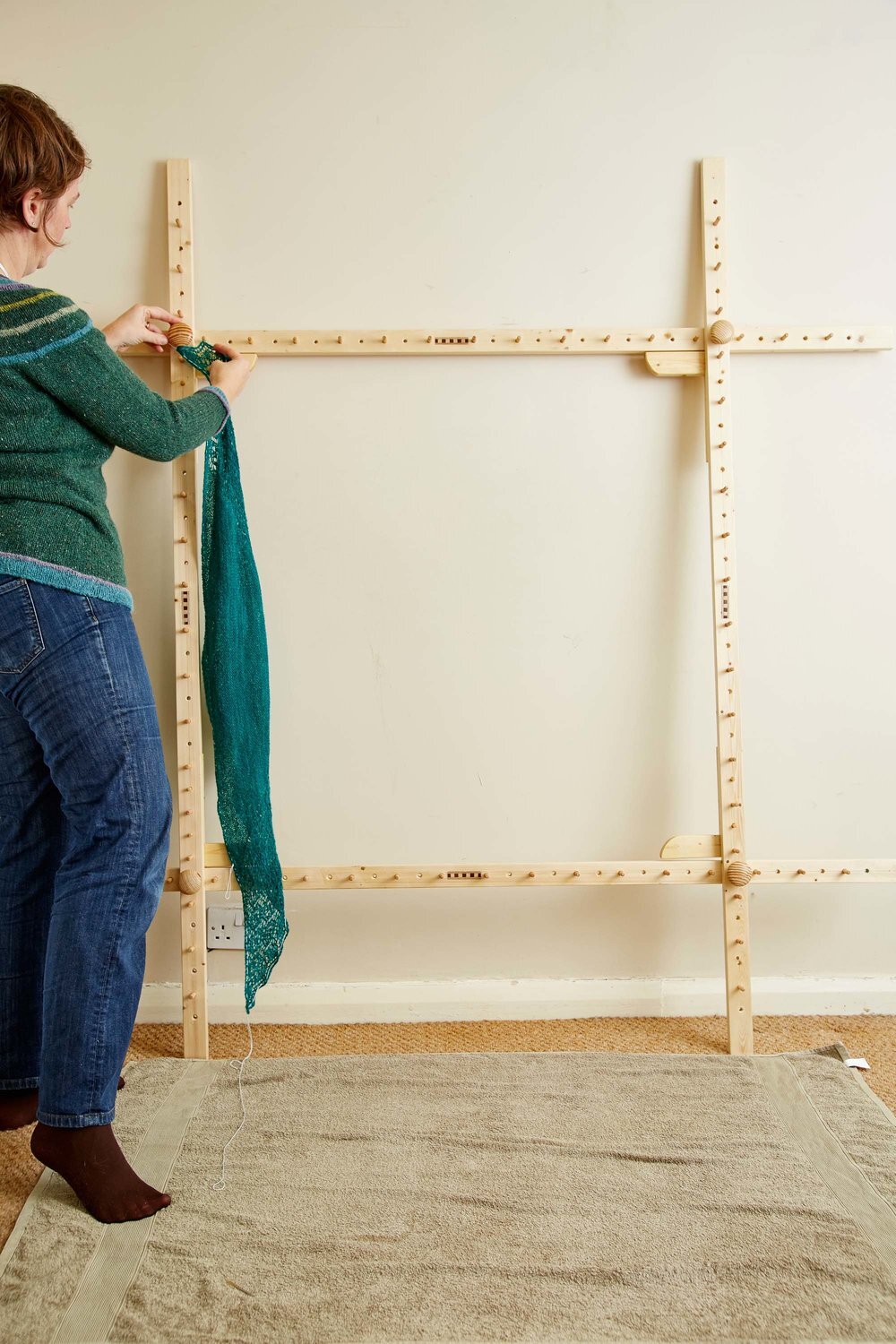Last week, we brought you a tutorial showing how to block a square or rectangular hap, or everyday shawl, using a blocking frame. Today, we bring you part two of this tutorial, using a frame to block a triangular hap or shawl.
USING A BLOCKING FRAME
Having cast off or grafted the final stitches of your hap, weave in all the ends, but do not trim them. As the lace is stretched, ends can pop out on the right side of the fabric, so it's best to wait until after blocking to trim them.
Decide on the dimensions you want to block your hap to, and cut a length of strong cotton about 50cm [20in] longer than the perimeter of your hap.
Using the screw knobs at the corners of the frame, set up your blocking frame so that the sides measure the same as your intended stretched hap. When blocking a triangular hap, make sure that from corner to corner along the frame (not on the diagonal), the side is at least as long as your intended stretched hap. My hap frame has slot-in corners to hold the frame at 90°, if yours does too, then fit them so that the frame doesn't keel over.
The initial steps for blocking a triangular hap are the same as when you block a square or rectangle. Take a length of strong cotton (I use 4ply mercerised cotton for this) and starting at a corner, thread it through the points on the edging of the hap. If your edging is intended to be straight, then sew the cotton along the edge weaving up and down every few stitches. Tie the ends of the cotton together in such a way that you can untie and adjust later if needed.
Soak your hap in lukewarm water with a little wool wash, until it is completely wet through. I use Eucalan since it doesn't require rinsing out. Then gently squeeze out as much excess water as possible, taking care not to twist and wring as this may damage the fibres. Place the wet hap on a dry towel and press it to remove as much remaining water as possible. You want your hap to be damp enough to stretch, but not soaking wet!
Hook the cotton at the corners of your shawl over the frame adjusting knobs.
If necessary, tighten the cotton so that the shawl will achieve your desired finished dimensions. You may need to give the shawl a good tug to do this. When I block square and rectangular haps or shawls, the tension from all round the perimeter makes this step unnecessary, but with a triangular shawl, there is no tension along the hypotenuse (or diagonal edge), so a bit more fiddling is required at this stage.
Work around the edges of the hap, looping the cotton thread over the pegs on the frame to divide each edge in half. Then divide those sections in half again, ensuring that the hap is stretched evenly. In order to fine tune how the hap is stretched, I then divide the number of peaks in each section between the number of pegs, and work around the edge, hooking the cotton over the remaining pegs with a standard number of peaks between each peg (some adjustment will be needed, unless you're very lucky!). This is just to ensure that you haven't got 3 peaks between pegs at one end, and 7 peaks at the other end of a side.
And leave your hap to dry!
The real beauty of using a frame is that it requires very little floor space. This is particularly handy in houses with children and or pets! You can lean your frame up to dry wherever you like - even moving it outdoors if the weather is nice. The right angle corner braces that came with my hap stretcher are particularly handy if you're going to move your frame, as they prevent the frame from leaning over and distorting your hap!
I hope you’ve enjoyed learning more about how you might use a hap stretcher to block a triangular hap. You can find tutorials for building your own, and they are also available to purchase. A version of this tutorial originally appeared on the blog in January 2017. In this tutorial, I’m blocking my Flukra Shawl, designed by Gudrun Johnston (she of many wonderful hap patterns!) and wearing my own design, the East Woodlands Sweater. All photos are by the always excellent Jesse Wild.
If you want more about lace blocking, do check out this month’s Confident Knitting tutorial, which focusses on how to block 3D lace objects, such as cowls. And our book Something New to Learn About Lace is chock full of tutorials on blocking using a range of tools! If a hap blocker is not in the books for you at the moment, we also have gorgeous Walcot Wires for blocking in the online shop!






